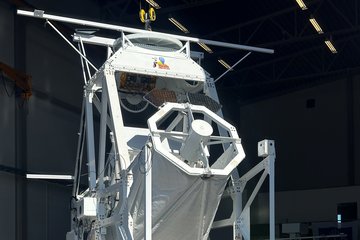All genres
1.
Journal Article
No evidence for synchronization of the solar cycle by a "clock". Astronomy and Astrophysics 671, p. A87 (2023)
2.
Journal Article
Loss of toroidal magnetic flux by emergence of bipolar magnetic regions. Astronomy and Astrophysics 636, A7 (2020)
3.
Journal Article
Solar activity: periodicities beyond 11 years are consistent with random forcing. Astronomy and Astrophysics 625, A28 (2019)
4.
Journal Article
Observing and modeling the poloidal and toroidal fields of the solar dynamo. Astronomy and Astrophysics 609, A56 (2018)
5.
Journal Article
Origin of the hemispheric asymmetry of solar activity. Astronomy and Astrophysics 618, A89 (2018)
6.
Journal Article
Solar Magnetoconvection and Small-Scale Dynamo Recent Developments in Observation and Simulation. Space Science Reviews 210 (1-4), pp. 275 - 316 (2017)
7.
Journal Article
An update of Leightons solar dynamo model. Astronomy and Astrophysics 599, A52 (2017)
8.
Journal Article
Understanding Solar Cycle Variability. Astrophysical Journal 843, 111 (2017)
9.
Journal Article
Solar Cycle 25: Another Moderate Cycle? Astrophysical Journal 823, L22 (2016)
10.
Journal Article
The turbulent diffusion of toroidal magnetic flux as inferred from properties of the sunspot butterfly diagram. Astronomy and Astrophysics 591, A46 (2016)
11.
Journal Article
Three-dimensional simulations of near-surface convection in main-sequence stars - III. The structure of small-scale magnetic flux concentrations. Astronomy and Astrophysics 581, A42 (2015)
12.
Journal Article
Three-dimensional simulations of near-surface convection in main-sequence stars - IV. Effect of small-scale magnetic flux concentrations on centre-to-limb variation and spectral lines. Astronomy and Astrophysics 581, A43 (2015)
13.
Journal Article
The crucial role of surface magnetic fields for the solar dynamo. Science 347, 1261470 (2015)
14.
Journal Article
Solar Dynamics, rotation, convection and overshoot. Space Science Reviews 196, pp. 79 - 99 (2015)
15.
Journal Article
The cause of the weak activity cycle 24. Astrophysical Journal 808, L28 (2015)
16.
Journal Article
Physical causes of solar cycle amplitude variability. Journal of Geophysical Research: Space Physics 119, pp. 680 - 688 (2014)
17.
Journal Article
Effects of the scatter in sunspot group tilt angles on the large‐scale magnetic field at the solar surface. Astrophysical Journal 791, 5 (2014)
18.
Journal Article
Generalized investigation of the rotation‐activity relation: Favoring rotation period instead of Rossby number. Astrophysical Journal 794, 144 (2014)
19.
Journal Article
Comparison of solar photospheric bright points between SUNRISE observations and MHD simulations. Astronomy and Astrophysics 568, A13 (2014)
20.
Journal Article
Magnetfelder auf der Sonne. Praxis der Naturwissenschaften - Physik in der Schule 2/63, pp. 26 - 30 (2014)











